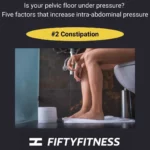Champion pelvic floor and five factors that put it under pressure

Champion pelvic floor – not just for keeping us dry
In some previous articles I’ve written about incontinence and the role that our pelvic floor muscles play in keeping our pants dry while we exercise and go about our daily lives.
As well as giving us control over the flow of wee and poo, the pelvic floor muscles play a role in supporting the pelvic organs and keeping them in place.
Prevention of pelvic organ prolapse is another reason for keeping our pelvic floor in good condition.
Pelvic organs and prolapse
The bladder, uterus and bowel are the main pelvic organs and the word ‘prolapse’ describes a situation where one or more of these organs becomes displaced and descends downwards.
A prolapsed bladder, uterus or bowel may bulge into the vaginal wall after it drops out of place.
There may be no signs of a prolapse initially, but it might be spotted during your routine pap smear.
If you’ve consulted a pelvic health physiotherapist for incontinence, which is a symptom of prolapse, they will be checking for it during the vaginal examination.
You may feel a lump or a pulling sensation inside your vagina, and a prolapse can even protrude outside the vagina and rub on your undies!
Our 50s is a time to be aware of prolapse
Our 50s is a time to be aware of prolapse because most of us will be experiencing perimenopause or menopause – here’s a quick refresher on the difference.

Perimenopause
The time of transition to menopause where oestrogen levels decline over an average period of 4 – 6 years.
Menopause
The moment in time one year after our last menstrual period.
After this time, we are menopausal, also referred to as post-menopause.
Why we need to look out for prolapse during this time
The decline in oestrogen that occurs during this time affects our production of collagen, which is the major component of connective tissue that occurs in bodily structures like bones, skin, tendons, ligaments, cartilage, and fascia.
The most obvious manifestation of the loss of elasticity and increased fragility of connective tissue that can occur as we get older is wrinkling of the skin.
But all connective tissue is affected, including that which contributes to holding the pelvic organs in place.
Consequently, a prolapse that you’re not aware of may worsen and become obvious during perimenopause or menopause.
Declining oestrogen is more likely to be a last straw
It’s important to note though that declining oestrogen is more likely to be a last straw in the manifestation of a prolapse with the risk of it occurring building up over time.
Intra-abdominal pressure
A major contributing factor to pelvic floor dysfunction and the risk of pelvic organ prolapse is increased pressure inside the abdomen which pushes down on the pelvic floor muscles causing fatigue and damage.
There are many things that raise intra-abdominal pressure and all of us will have had one or more of these factors at some stage in our lives.
Factors that increase intra-abdominal pressure
There are a range of common occurrences and conditions that increase intra-abdominal pressure, increasing the risk of pelvic floor dysfunction and pelvic organ prolapse
I’ll explain five of these.
- Pregnancy and childbirth
- Constipation and straining to poo
- Being overweight or obese
- Sneezes, coughs, and vomits
- High intensity exercise
1. Pregnancy and childbirth
Childbirth is the commonly known cause of pelvic floor muscle damage and subsequent prolapse, but we need not have experienced vaginal delivery to be at risk.
The trauma of childbirth can damage the muscles directly, but the pressure inside the abdomen that builds up over the course of a pregnancy is a huge factor.
You might wonder why you have problems with incontinence or prolapse if you only had caesareans, but the growing baby itself puts immense pressure on the pelvic floor.
My initial denial and confusion about my incontinence related to the fact that I’ve never had a baby, but there are other factors that increased my intra-abdominal pressure and affected my pelvic floor.

2. Constipation and straining to poo
Oversharing alert!
I’ve experienced dreadful constipation at various times throughout my life, most recently it was one of my perimenopause symptoms.
Constipation is a problem for the pelvic floor in two ways.
Firstly, carrying a lot of poo around that you can’t pass increases the pressure inside the abdomen.
Then straining while trying to poo raises the stakes considerably.

3. Being overweight or obese
I was overweight throughout my life too and carried most of my excess body fat on the belly.
Being overweight or obese, especially with an apple shape like mine, also contributes to increased intra-abdominal pressure.

4. Sneezes, coughs, and vomits
It makes sense that sneezing, coughing and vomiting increase the pressure on our pelvic floor muscles because most of us have felt that we might, or actually do, leak a bit of wee when experiencing these reflexes.
It’s difficult to avoid doing these things if they occur during an acute illness, but we can manage the symptoms while we ride it out.
What’s important to look out for are situations where we may be sneezing or coughing on a long-term basis, like chronic hay fever or a smoker’s cough.
The sustained increase in intra-abdominal pressure through repetitive sneezing, coughing and vomiting is very hard on the pelvic floor muscles.
Getting help to stop smoking or relief from chronic conditions involving these symptoms is a great support to your hardworking pelvic floor.

5. High intensity exercise
The other common culprit in pressurising the abdomen and pelvic floor is high intensity exercise.
Just about any exercise you can think of is responsible, and those of us who have wet their pants during exercise will be able to name specific examples.
I call out skipping, but literally all exercises that I do increase intra-abdominal pressure.
Running, lifting weights, jumps and other repetitive, vigorous movements all add to the strain.

Herein lies a dilemma
Exercise is vital for our health and wellbeing, but it can damage our pelvic floor.
The great news is that we can exercise vigorously and look after our pelvic floor at the same time.
I’ll explain how in a future article, but you’re welcome to dive in with my free video series.
Learn 6 ways to take the pressure off your pelvic floor while you exercise – FREE video series
Women over 50 face a big DILEMMA! It’s a critical time for us to be exercising for bone strength and health, but exercise can contribute to pelvic floor dysfunction. What on earth are we supposed to do?
With this informative video series, you’ll learn six easy strategies that will take the pressure down! You’ll feel confident to keep up your physical activity while taking care of your pelvic floor.
Every day for 6 days you’ll receive and email from me with a video of each strategy so you can learn them one at a time. On the 7th day I’ll send you an e-booklet with all 6 strategies collated in one handy resource that you’ll have forever.
The video series is ready – start learning the 6 strategies now!
https://bit.ly/TakeThePressureDown
Keep in touch
Please reach out to me if anything in this article resonates with you.
You can email me at kate@fiftyfitness.com.au or connect via social media.

Subscribe now
Blog Subscription Form
A blog subscription form, used for the blog page and posts.
"*" indicates required fields